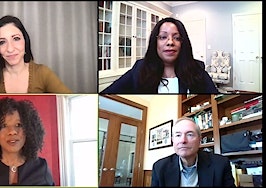The faces of homebuyers are changing and the coronavirus pandemic is making their challenges worse, according to panelists at the National Association of Realtors’ Real Estate Forecast Summit on Thursday.
The panelists were Dr. Richard Fry, senior researcher at the Pew Research Center; Dr. Rodney Harrell, vice president of family, home and community at AARP; and Dr. Jessica Lautz, vice president of demographics and behavioral insights at NAR. Sarah Paynter, a real estate reporter from Yahoo Finance, was the moderator.
Paynter began by noting that the share of first-time homebuyers had dipped to 31 percent this year, the lowest rate since 1987, and much lower than the 40 percent or so share in a typical year. Lautz noted only a quarter of first-timers received down-payment assistance from family this year, down from about a third usually.
“There could be some family members who aren’t able to contribute that transfer of wealth that … is so essential for first-time homebuyers to be able to enter homeownership, especially with home prices rising so steeply, ” she said.
“Without that assistance, I think that that really does retract, as well as the low inventory and the tightened supply, the rising prices, all of these other headwinds that are approaching as well as student loan debt. So they have a lot of hurdles, but then without that extra push from mom and dad, it’s really hard to enter.”
Millennials, who make up the bulk of first-time buyers, do not have lower incomes than their predecessors, but do lag in wealth, in part because of student loan debt, which averages at about $24,000 compared to about $12,000 in student debt for the Gen X population 20 years ago, according to Fry.
“And lending standards are still fairly tight, not locked-drum tight, but they need a fairly good credit score to qualify, so as Jessica mentioned, they are facing some headwinds,” he said.
‘Baby bust’
The U.S. population is projected to grow by about 7 percent in the 2020s — the smallest rise over a decade since the 1930s, according to Fry.
“The U.S. population is not vigorously growing,” he said. “Furthermore, that was based on 2017 projections. In 2020, we had a pandemic. Immigration was already running under lower numbers. I suspect that the pandemic has markedly brought down immigration and so that 7 percent is probably optimistic.”
The nation is aging, Harrell said. “Sometime in the 2030s, we’re going to have for the first time, people over the age of 65 outnumber those 18 and under,” he said. “That’s a fundamental change to our housing market that’s impacting communities across the country.
“We need to look across all those age ranges to understand the type of housing that works for folks, and also just the complexity of those transfers and which groups’ needs are being met. Our vision of communities has to be changed to one that does look at what boomers are thinking about, what millennials are thinking about, and everyone in between.”
The “baby bust” that was happening before and possibly during the pandemic has “huge implications” for homebuyers, according to Lautz.
“It really is pronounced in the data,” she said. “For homebuyers looking back at 1985, 58 percent of them had kids under the age of 18 in the home. Today it’s just a third.”
That’s going to affect preferences in terms of how important (or not) schools are for families and in terms of the amount of space needed in a home, she said.
Need for multigenerational housing
AARP’s livability index shows that four out of five neighborhoods in the U.S. have nothing but single-family housing, according to Harrell.
“Do we have those housing options that allow a single person or a multigenerational family or a couple or a larger family to get what they need?” he said. “The answer, in short, is no, that in many neighborhoods that’s not possible.
“We need to think about producing what some call ‘the missing middle’ housing — the two flats and triplexes and accessory dwelling units and some of the other things that allow people to have a better chance of finding the option they need.”
The share of homebuyers purchasing multigenerational homes has increased from 11 percent pre-pandemic to 15 percent during the pandemic, according to Lautz.
“That’s a massive jump,” she said. “The number one reason we saw that jump was for aging adult relatives to move into the home. Last year when we looked at the data pre-pandemic what we saw is it’s essentially an even split between aging adults who are moving into a home and then young adults who are boomeranging back perhaps.
“So what you’re really seeing is this rise, nearly 50 percent, of multigenerational buyers in the pandemic wanting an aging adult relative with them, ” she added. “I’m sure there’s a lot of reasons behind that — perhaps child care factoring in there but also taking care of this aging adult relative, staving off loneliness as well as isolation if they’re living independently.”
But Lautz said she doesn’t know if the nation’s housing stock, much of which is older, is going to be able to support that trend. Harrell urged attendees to support building housing with universal design such as no-step entrances and to help take down zoning barriers to different types of housing in order to make housing stock work across generations.
He noted that AARP has been tracking nursing home deaths from COVID-19 across the country and that thus far, 106,000 residents and staff of nursing homes across the country have died due to the virus.
“That’s 106,000 families that are impacted by that and many others that are thinking about those issues,” he said. “So, anecdotally, we’ve been seeing a lot of people that are interested in options like accessory dwelling units this year, building a backyard apartment or the like so that they could either have a family caregiver to help take care of a loved one or to have their loved one in the house for a longer time period.”
Others are considering shared housing and multigenerational housing, he added. “Longer term, we need to be thinking about those options,” he said. “Not just about how we can rethink nursing homes in our care sector, but again, back to those housing options so that fewer people would have to be at a nursing home or in any housing situation that doesn’t work for them.”
Fry pointed out that about 20 percent of the population lives in a multigenerational household, but that such households should not necessarily be associated with senior housing.
“Which age group is the most likely to live in multigenerational households? It’s now 25-to-29 year olds,” he said. “About a third of them live in multigenerational households, whereas about a quarter of 85 and above live in a multigenerational household. Back in 1980, about 13 percent of 25-to-29 year olds lived in a multigenerational household.”
Hispanics, Asian Americans, and African Americans are more likely to live in multigenerational households, he added.
“Hispanics and Asians, those are the growing portions of the population,” Fry said. “As the population grows more diverse, and most demographers expect it to over the next few decades, that’s giving a demographic basis to why we’re likely to see continued growth in multigenerational living as the population continues to grow more racially and ethnically diverse.”
It’s important to meet the needs of people at any life stage, regardless of generation, Harrell said.
Racial disparities in housing
Paynter noted that only 17 percent of homebuyers in 2020 were minorities while Lautz and Fry broke down the homeownership rate in 2019 by race: 73 percent for whites, 42 percent for blacks, 58 percent for Asian Americans and 48 percent for Hispanics.
Fry said he expected the gap between whites and Hispanics to narrow a little as the Hispanic adult population shifts to being less foreign-born, more highly educated and with higher incomes. Minorities made up 26 percent of first-time buyers this year, according to Paynter.
“We should see more diversity among our first-time homebuyers as they do join the home buying market,” Lautz said. “That being said, they have a ton of headwinds. We talked about low inventory, especially for the affordable price points for entry-level buyers, and thinking about the affordability gap that we have there with housing as well.”
While the American dream of homeownership is very strong among all races, the ability to enter homeownership is “so difficult” for first-timers, she added.
“The big thing that has been missing historically is for Hispanic homebuyers and for African-American homebuyers, they’re less likely to have family help,” she said. “And so as they enter that proposition, being able to save for that down payment as essentially the goalpost is moved on a monthly basis as they see home prices rise, that could just be very, very difficult.”
Harrell noted that the coming pandemic-induced wave of foreclosures and evictions will hurt African American and Latino communities the most. ‘Those impacts don’t happen evenly,” he said. “We may see even larger dips as things move forward and that should be a concern for all of us.”
While the Federal Reserve just announced that aggregate wealth is at record levels across the country, income and wealth gains are not evenly distributed across racial groups and neither is the pandemic’s impact on the labor market, Harrell added.
Lastly, the panelists touched on the growing share of buyers who are not married couples. While 62 percent of buyers are married couples, that’s much lower than we’ve seen historically, according to Paynter.
Lautz said single females have been second only to married couples among buyers, but that their share has actually shrunk in recent years.
“I think some of that has to do with housing affordability,” she said. “It’s really hard for a single female, traditionally on a lower income, to be able to save for that down payment and bring that money to the table.
“That being said, in the pandemic and in recent years what we’ve seen is a really big rise in unmarried couples and in roommates purchasing homes together. I think it’s a fascinating trend.”













